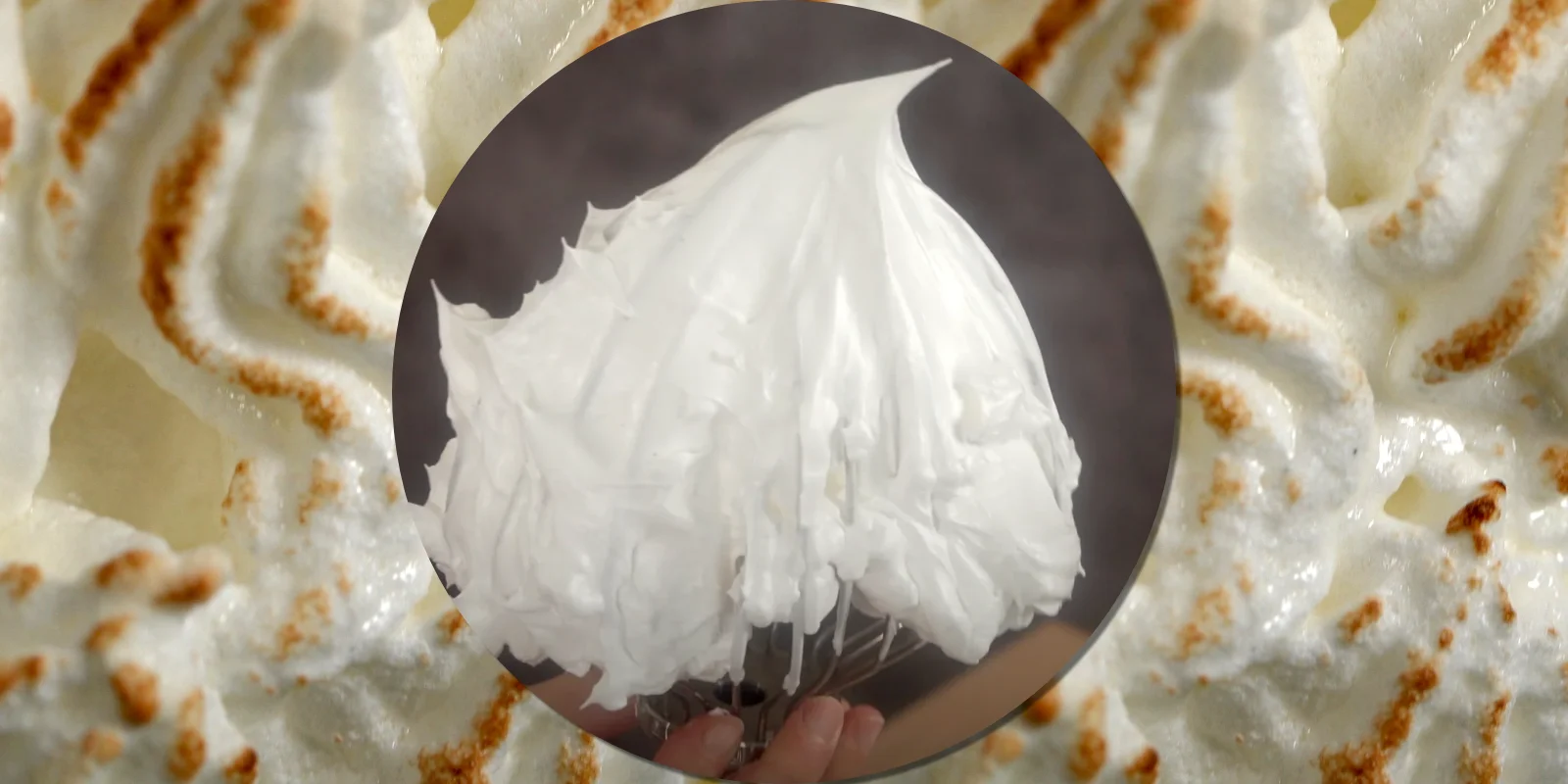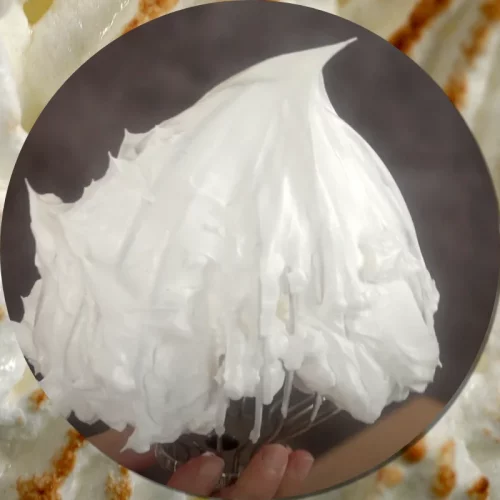Once you learn how to make Swiss Meringue, the doors of the pastry and baking world open at your feet! While it has the reputation for being a difficult or finicky recipe, making Swiss Meringue is quite simple once you know a few simple tricks. And because a video is worth 1000 words and pictures, we highly recommend you watch the video recipe below to understand how simple the recipe is!
Watch the Video Recipe!
We demonstrate how to make Swiss Meringue in this video recipe for Bombe Alaska. It is a critical ingredient for this famous dessert!
Subscribe to our YouTube Channel
More video recipes? Subscribe to our YouTube Channel (it’s FREE) and click the bell to get notifications when we release a new video recipe!
Making Swiss Meringue
We need just the whites (not the yolks) for making Swiss Meringue. To make Swiss Meringue, it’s important to separate the eggs (yolks from the whites) cleanly to be sure there is no yolk in the whites that we will be whipping.
Cardinal Rules for Making Swiss Meringue
- Separate eggs cold —yolks that are cold keep their shape better and are less likely to bust open into the whites
- Previously frozen egg whites will work too—we’ve made many types of meringue successfully with previously frozen whites.
- Free of fat—bowls and utensils touching the egg whites should be free of fat. Fat prevents whites from whipping well.
How to Separate Eggs (Whites from Yolks)
As we just mentioned, egg whites will not whip properly if there is any fat or grease in them—that includes the egg yolk! So, we need to crack our eggs to be sure no yolks bleed into the whites.
Here are a few more tips for cleanly separating egg whites from yolks:
- Hands are the best tool for separating eggs—let the whites slip through your fingers into a bowl as the yolk stays in your hand
- Crack each new egg over a smaller bowl, using your hand to catch the yolk
- Egg white free of yolk? Only then transfer it to the larger bowl where you are collectiong the whites
Why the second smaller bowl? Cracking each egg over a second bowl allows you to be sure the whites from that egg have no broken yolk before transferring the whites to the bowl of cleanly separated whites. If you crack each new egg over the bowl of clean whites, one mistake (a bit of yolk getting through) can destroy the entire batch of whites. This is annoying and a waste of eggs!
We know that there are a ton of different methods for separating the eggs. Some people pass the egg yolk between the two shells, letting the egg white fall into the bowl beneath. Others rely on a commercial egg separator (affiliate link) to do the job. However, we think the shell and tools are just more likely to bust open that delicate yolk. Sometimes the best tool for the job is the cheapest: your hands!
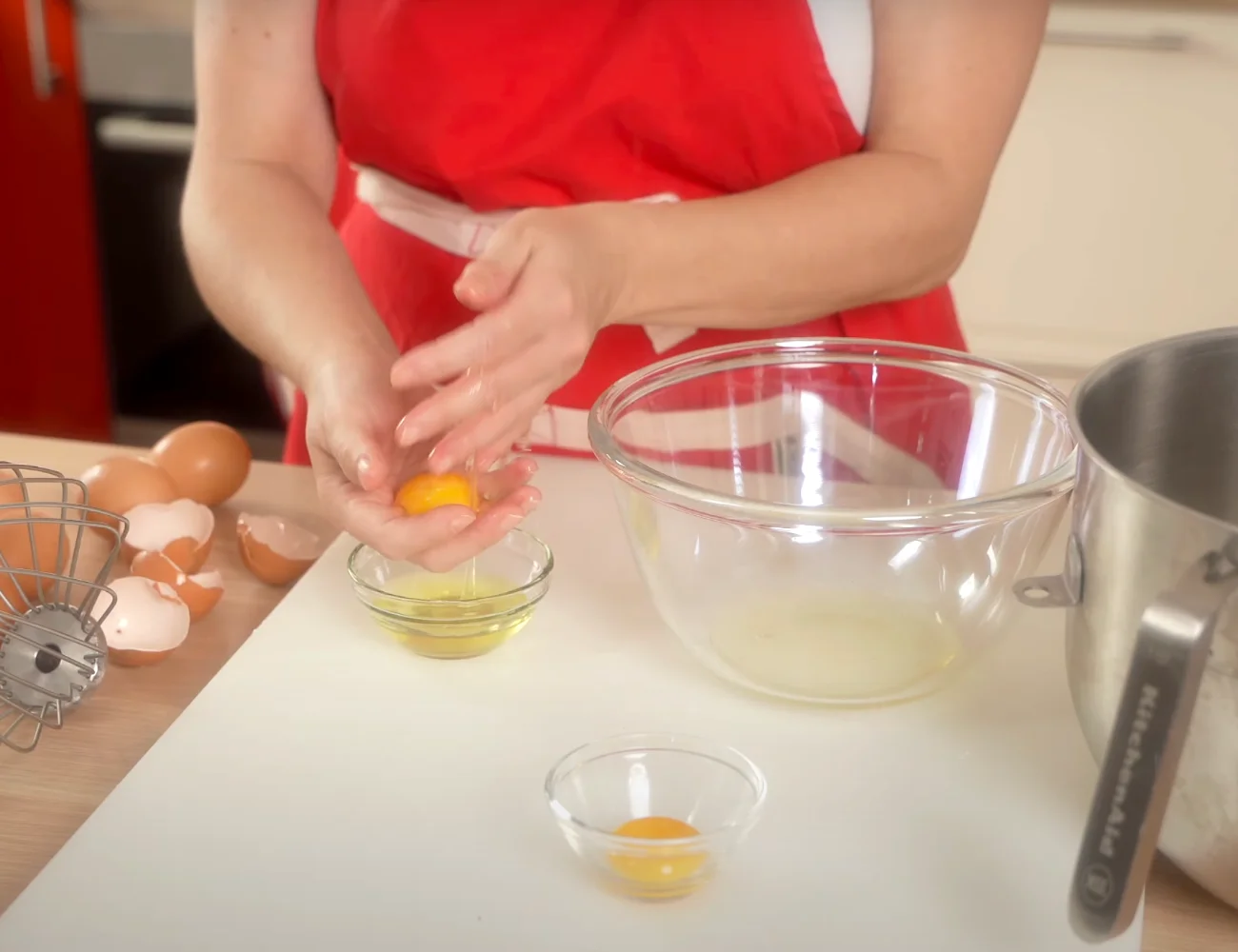
Why Separate Eggs Cold?
You’ve probably read that egg whites whip better warm. For this reason, some people make the mistake of leaving their eggs out to come to room temperature in the shell before cracking them. This is a bad idea because the yolks in room temperature eggs tend to be more prone to busting open when you try to separate the eggs.
It’s much better to separate eggs cold, then bring the egg whites to whatever temperature you want them to be to whip them. For making Swiss Meringue, we actually need to warm the whites considerably before whipping them.
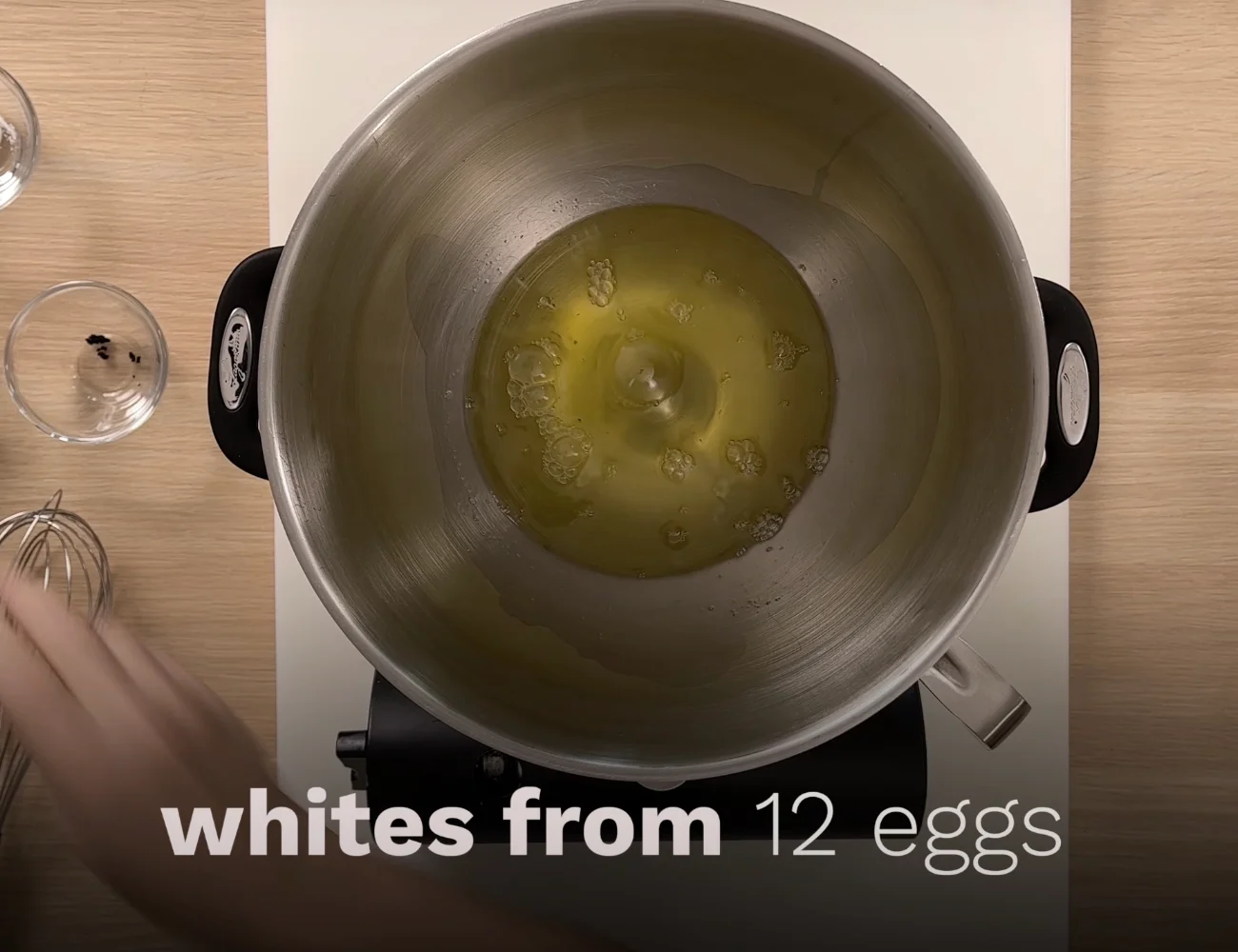
Warm the Egg Whites + Sugar
To make a Swiss Meringue, we need to use a double boiler—called a bagnomaria in Italian. This allows us to use indirect heat to gently heat our sugar and egg whites.
What is a Double Boiler (AKA ‘bagnomaria‘)
A double boiler is something you can easily make at home with no special equipment. All you need is a pot and a bowl that can mostly fit in that pot. The whole bowl doesn’t need to fit in the pot, but most of it should.
Then, you add about an inch of water to the bottom of the pot. The pot should be big enough to hold the bowl with the egg whites and allow the bottom of that bowl to just touch the water or be suspended above it. The ingredients you want to warm or cook go into the bowl.
The water in the pot of a bagnomaria can be brought to boil, then removed from the heat. Or, it can be left simmering very gently on the heat source.
To make a Swiss Meringue, we want the water gently simmering.
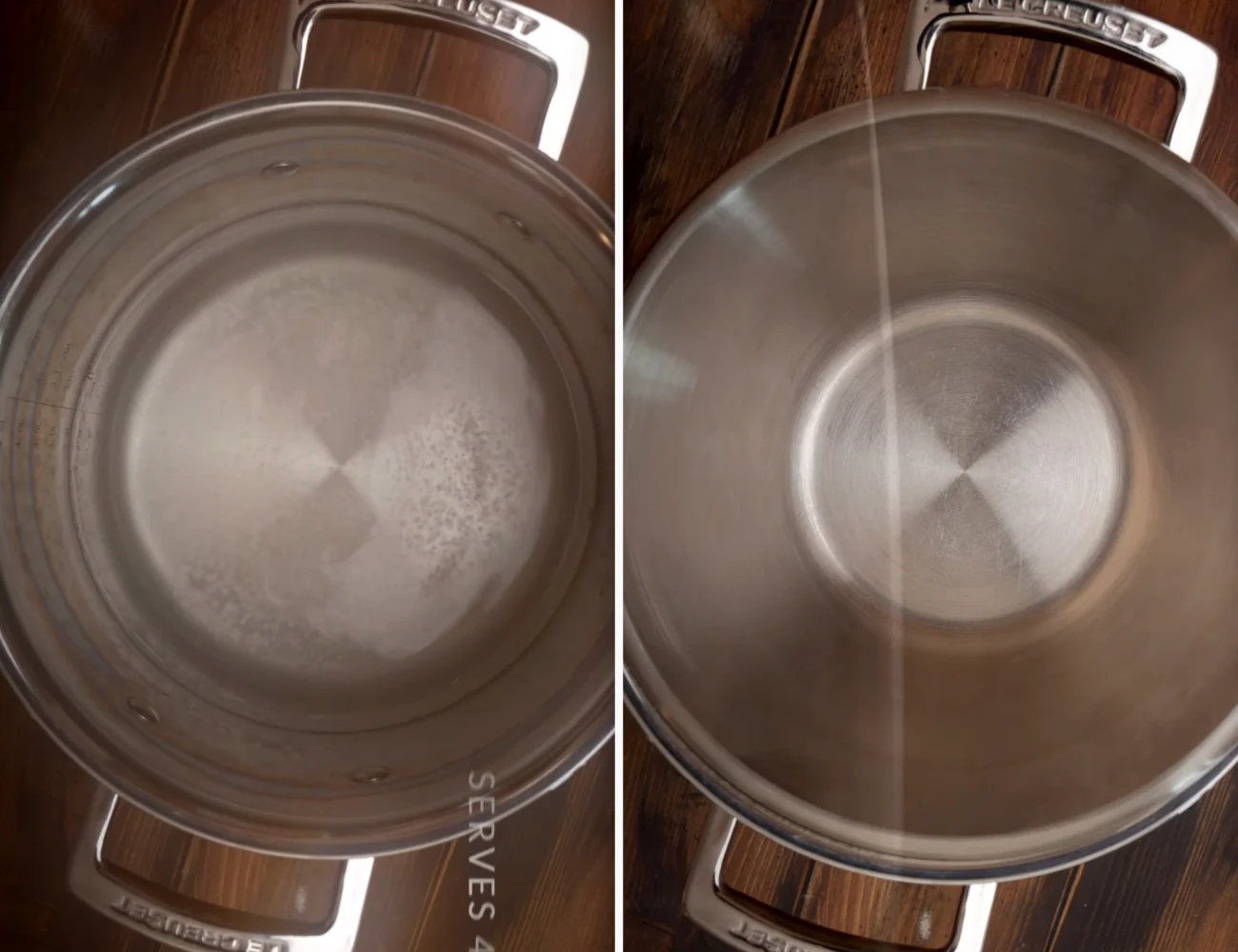

There are two parts to making a Swiss Meringue. First we need to dissolve granulated sugar into egg whites, warming the mixture while whisking frequently. Later, we whip the warm mixture on high speed until it is the right stiffness for our recipe.
First part first, we combine the granulated sugar with the egg whites.
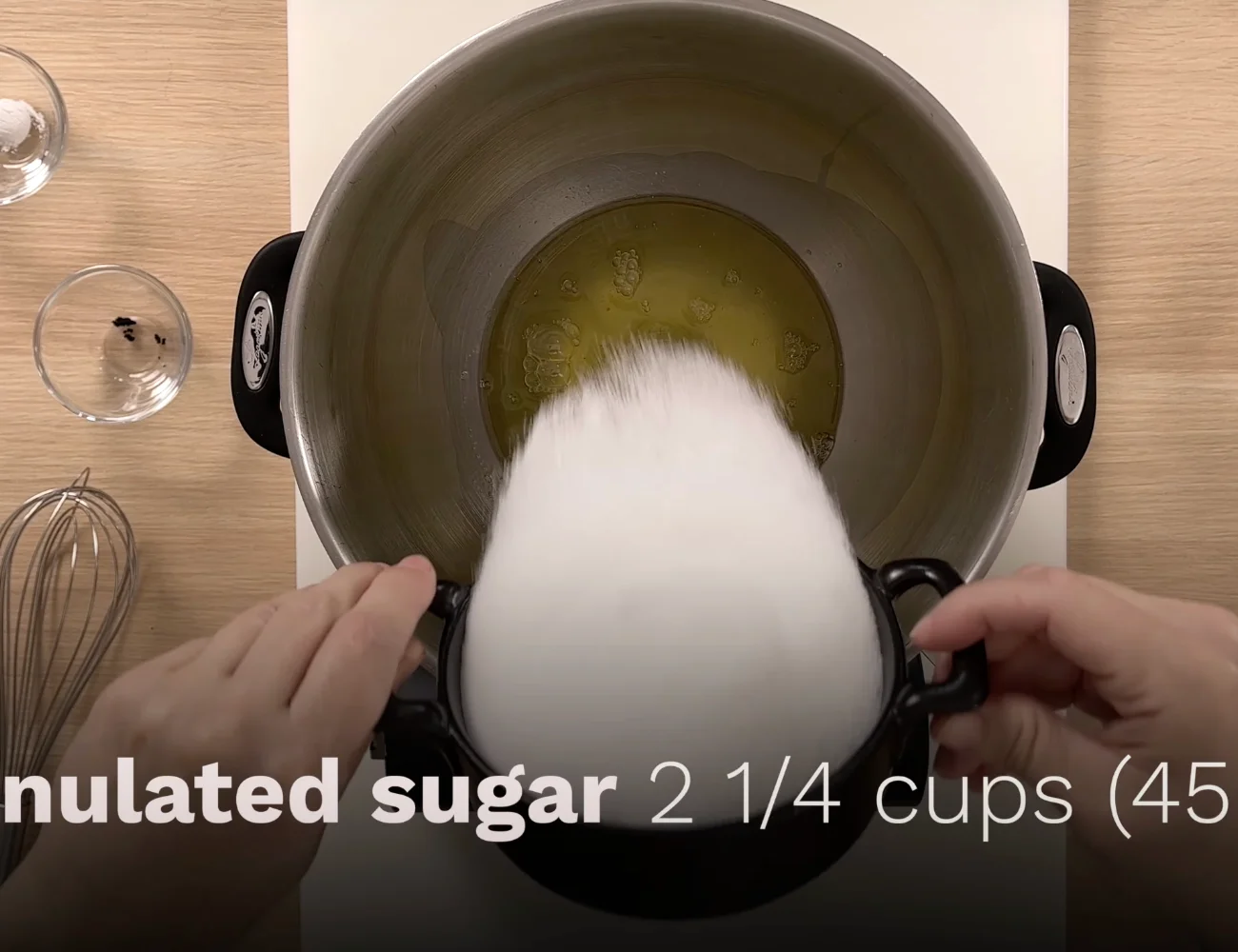
If we warm the eggs and sugar enough, we can effectively kill food any bacteria that might be in the egg whites, making this meringue safe to eat without any further cooking. In contrast, some meringues require the baking step to kill any bacteria that might be in the whites.
At first the eggs and sugar will be dense and hard to whisk. Then, the sugar will dissolve and the mixture will be thin and easy to whisk. Finally, the eggs will begin to froth. At this point, we need to use a candy thermometer to watch our temperature very closely, whisking continuously.
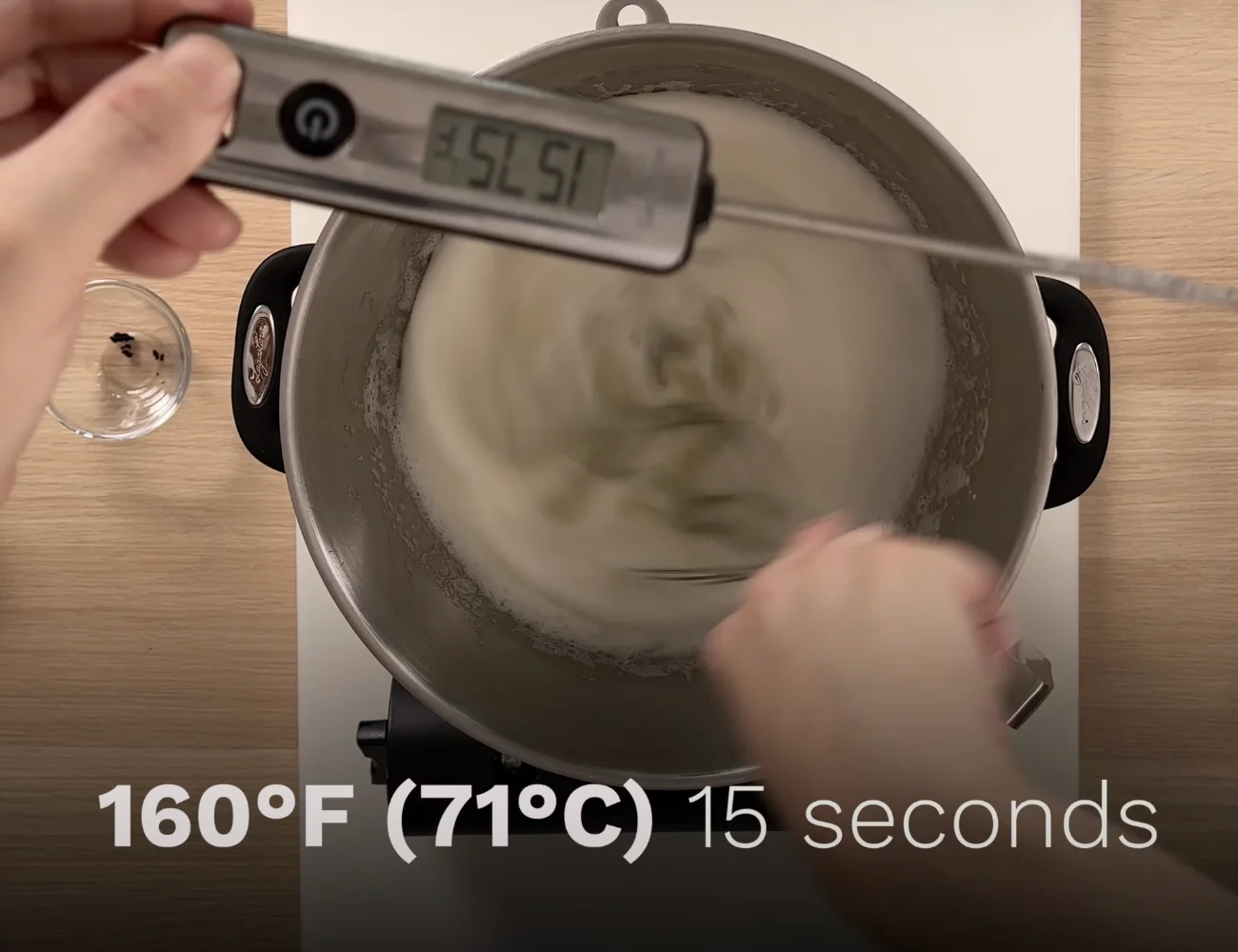
When we reach 160° F (71° C), continue cooking and whisking the eggs for 15 seconds. The FDA recommends cooking eggs to this temperature to maximize food safety.
Whisk Warm Eggs on High
Remove the eggs from the heat. Add a bit of cream of tartar for extra stability and a half a vanilla bean for extra flavor. Using a stand mixer or hand mixer with a whisk attachment, whip the warm egg whites on high speed for about 5 minutes— or until you reach the level of ‘stiffness’ that your recipe calls for.
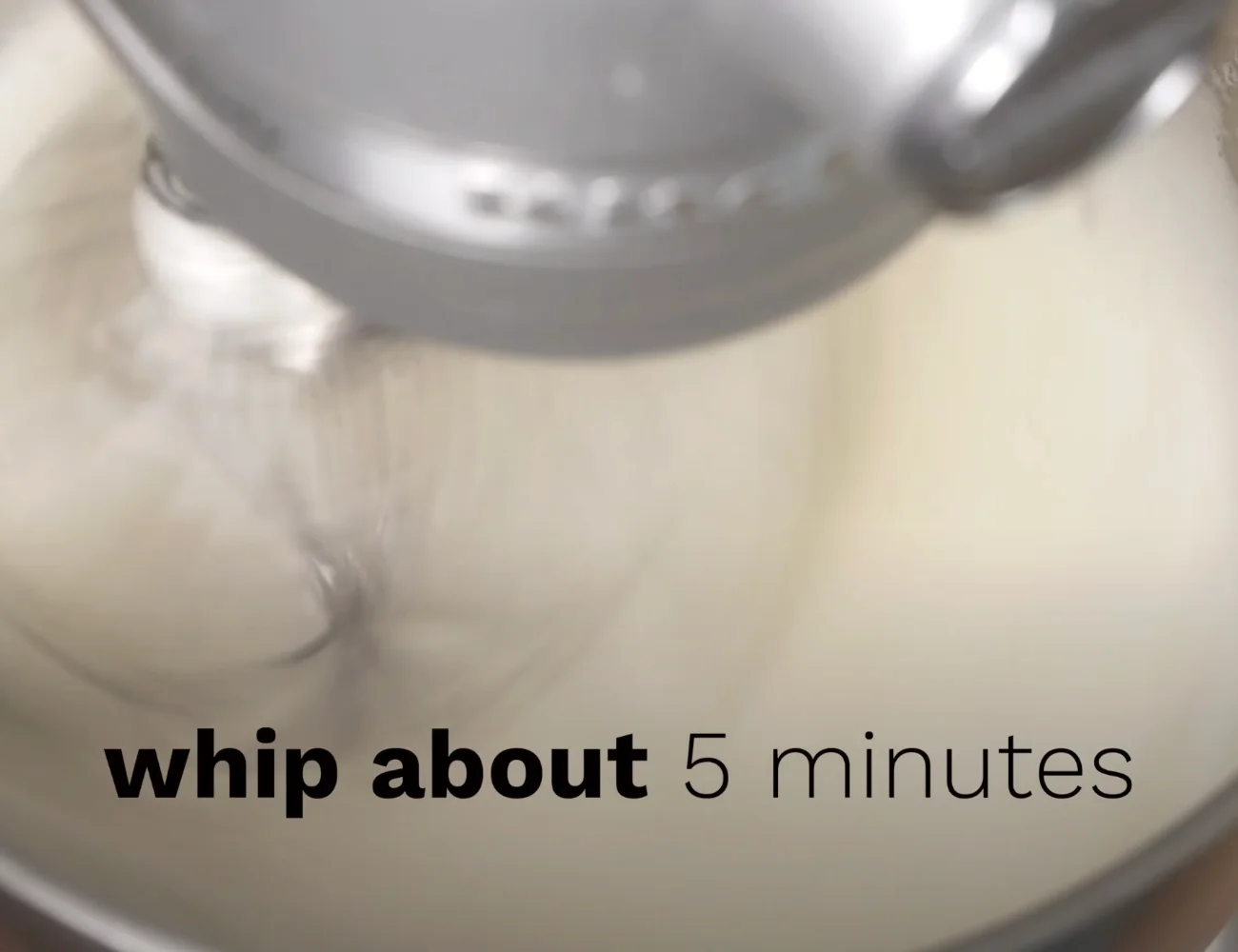
Testing Peaks for Stiffness
To test the meringue for stiffness, dip a whisk (even the whisk you are using) straight into the meringue and pull up slowly. Turn the whisk right side up. Then, look at the peaks that the Swiss Meringue has formed.
Soft peaks stand up but the points droop down a lot. Firm meringue have peaks that stand up straight— with a tiny curve at the top! Stiff meringue have peaks that stand straight with no curve. The Swiss Meringue peaks below are very firm.
The final Swiss Meringue will be glossy, dense and marshmallow-like in consistency. It’s a very stable meringue!
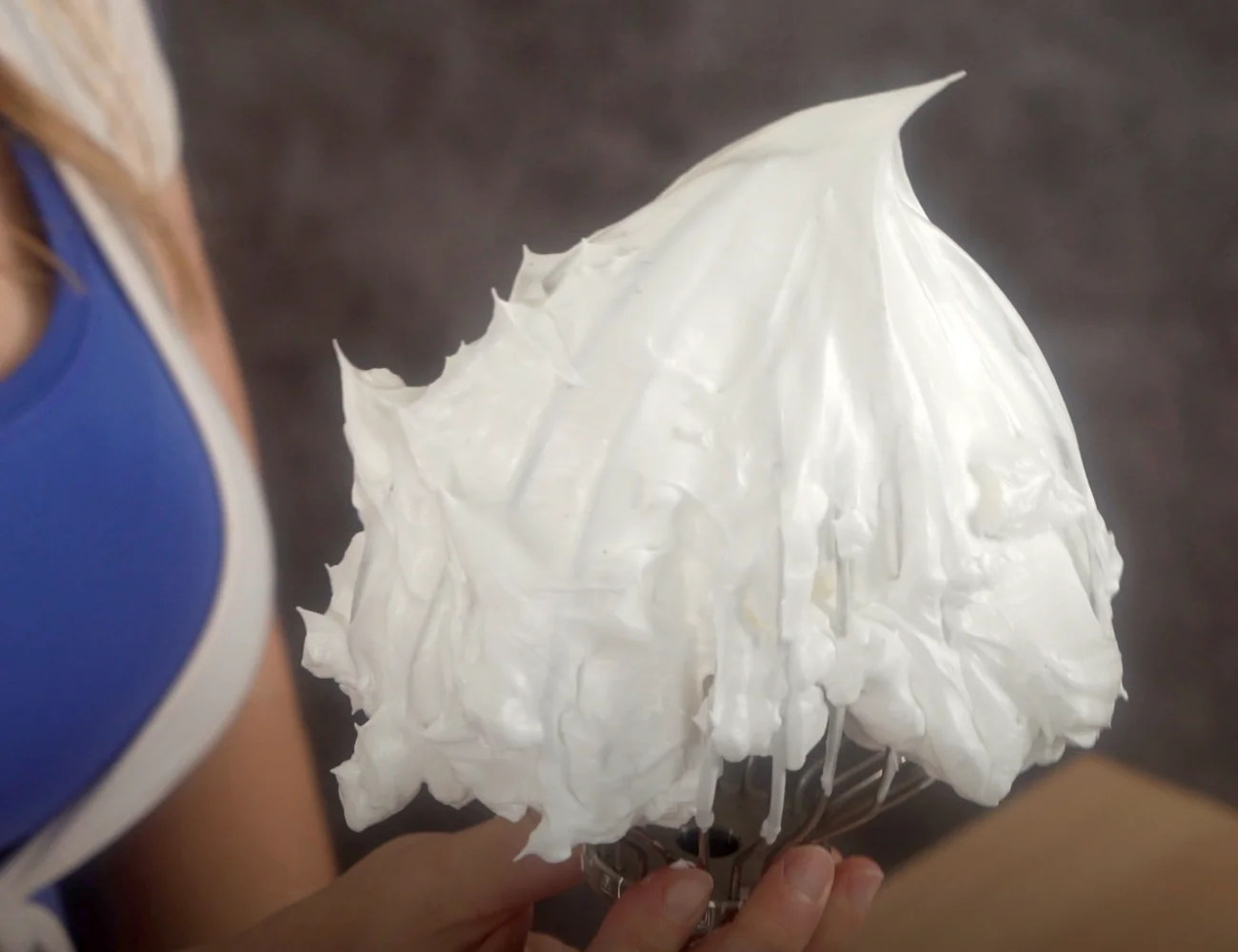
What is Swiss Meringue Used for?
Baked Alaska and Bombe Alaska
The photos you see on this page were taken from a Swiss Meringue we made for a Bombe Alaska dessert. In the 1800’s, it was discovered that whipped eggs are crazy good insulators. And so some desserts were invented to prove that point by covering ice cream in meringue and then baking that ice cream… or even setting it on fire! So that’s one way to use a Swiss Meringue!
Pie Toppings
One great use for Italian or Swiss Meringue is as a pie topping! We top lemon curd tarts or cream pies with piped Swiss Meringue. It’s already cooked, and so all you need to do is torch it (optional) to give it a tasty, toasty appearance.
Swiss Meringue Buttercream
Swiss Meringue buttercream is a popular frosting for cakes. In that recipe, a Swiss Meringue is beaten with butter. Swiss Meringue Buttercream is silky smooth, lighter and less sweet than many other types of buttercream frostings. We love it!
As an Amazon Associate, we earn from qualifying purchases. This means at no extra cost to you, PIATTO may earn a small commission if you click the links and make a qualifying purchase.
How to Make Swiss Meringue
Equipment
- 1 stand mixer or hand mixer Ours? Kitchenaid Pro 600: https://amzn.to/3gVNnBQ (affiliate link)
- 1 large bowl about 9" diameter at the top
- 1 candy thermometer for checking the temperature of the Swiss Meringue
- 1 double boiler (homemade) pot + bowl for making the Swiss Meringue
- 1 kitchen blow torch optional: to add toasted accents to the Swiss Meringue and loosen bowl from frozen ice cream
Ingredients
Swiss Meringue
- 12 egg whites
- 2 ¼ cups white granulated sugar
- 1 tsp vanilla extract or ½ vanilla bean
- ¾ tsp cream of tartar
Instructions
Make the Swiss Meringue
- Separate the whites from the yolks of the eggs. We only need the whites for this recipe.12 egg whites
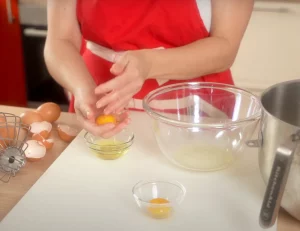
- Add the whites and granulated sugar to a bowl sitting over a pot of gently simmering water. This is called a double boiler and it allows us to use indirect heat to gently heat our sugar and egg whites.2 ¼ cups white granulated sugar
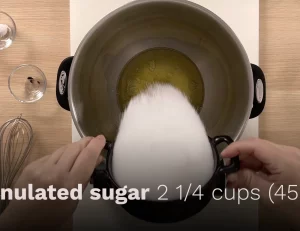
- Combine the granulated sugar with the egg whites. Warm the mixture over a gently simmering double boiler to dissolve the granulated sugar into egg whites. Whisk frequently.
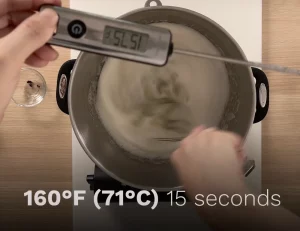
- At first the eggs and sugar will be dense and hard to whisk. Then, the sugar will dissolve and the mixture will be thin and easy to whisk. Finally, the eggs will begin to froth. At this point we need to watch our temperature very closely, whisking continuously.

- When you reach 160° F (71° C), continue cooking and whisking the eggs for 15 seconds. This will ensure we kill bacteria that can cause foodborne illness.

- Using a stand mixer or hand mixer with a whisk attachment, whip the warm egg whites on high speed for about 5 minutes. Add cream of tartar for extra stability and a half a vanilla bean for extra flavor before whipping.1 tsp vanilla extract, ¾ tsp cream of tartar
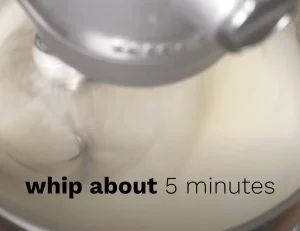
- Whip until you have reached the level of meringue stiffness called for in your recipe! Baked Alaska, for instance, requires firm to stiff peaks.
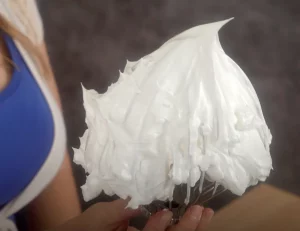
Video
🇬🇧 This is the English-language version of our original Italian recipe on PIATTO Ricette.
